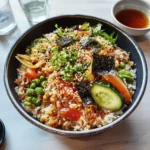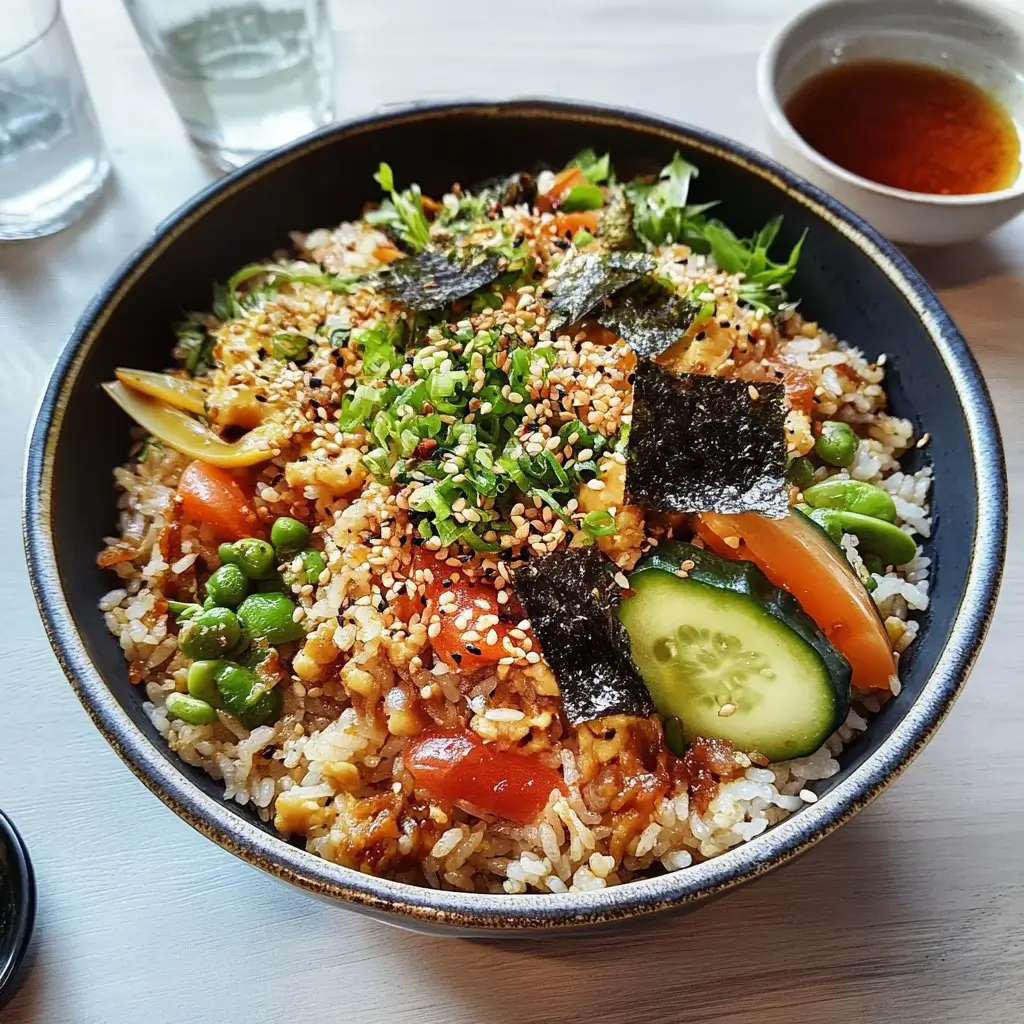The aroma of Japanese fried rice, or Yakimeshi, instantly transports me back to bustling little eateries in Tokyo, the rhythmic clatter of spatulas against well-seasoned woks, and the comforting, savory steam обещающий a delicious meal. For years, I tried to replicate that specific, subtly sweet, and deeply umami flavor at home. While many fried rice recipes are delicious, there’s a certain finesse to the Japanese version. After much delicious experimentation, this Vegetarian Japanese Fried Rice recipe has become a cherished staple in my kitchen. My family, including my sometimes-picky teenager, adores it. They love the perfectly cooked rice grains, each distinct yet tender, the colorful medley of vegetables, and the satisfyingly savory tofu. It’s quick, it’s packed with goodness, and it truly captures that authentic Japanese essence, all without any meat.
The Unique Charm of Vegetarian Japanese Fried Rice (Yakimeshi)
Before we embark on the culinary journey of creating this dish, let’s explore why Vegetarian Japanese Fried Rice, or Yakimeshi (焼き飯), holds such a special place in the world of comfort food. It’s more than just “fried rice”; it’s a specific style with its own characteristics.
- Subtle yet Profound Flavors: Unlike some bolder, more heavily sauced fried rice varieties, Japanese Yakimeshi often boasts a more delicate and balanced flavor profile. The seasoning aims to enhance, not overwhelm, the natural taste of the rice and vegetables. Key ingredients like Japanese soy sauce (shoyu), mirin, and sometimes sake, contribute to its unique umami depth.
- Emphasis on Rice Texture: Japanese cuisine places great importance on the texture of rice. In Yakimeshi, the goal is to have individual grains that are perfectly cooked, slightly chewy, and separate, yet with a comforting cohesiveness that often comes from using Japanese short-grain rice.
- A Celebration of Vegetables: This vegetarian version truly allows the vegetables to shine. The careful selection and dicing of ingredients like carrots, peas, corn, onions, and mushrooms contribute not only to the flavor but also to the visual appeal and textural variety of the dish.
- Wholesome and Satisfying: Packed with plant-based protein from tofu or edamame, and a rainbow of vegetables, this dish is both nutritious and incredibly satisfying. It’s a complete meal in one bowl.
- Quick and Versatile: Once your ingredients are prepped (the crucial “mise en place”), Japanese fried rice comes together very quickly, making it an ideal weeknight dinner. It’s also a fantastic way to use up leftover rice and vegetables.
- Adaptable to Vegan Diets: While traditional Yakimeshi might sometimes include egg, this vegetarian version can easily be made fully vegan with simple considerations, ensuring everyone can enjoy it.
This Vegetarian Japanese Fried Rice is not just about creating a meat-free alternative; it’s about crafting a dish that stands proudly on its own, showcasing the best of Japanese culinary principles – balance, freshness, and umami.
Understanding Key Differences: Yakimeshi vs. Other Fried Rice Styles
While “fried rice” is a broad term, Japanese Yakimeshi has nuances that set it apart, particularly from its popular Chinese counterpart, Chahan (which itself has many regional variations).
- Rice Type: Yakimeshi traditionally uses Japanese short-grain rice (like uruchimai, the same type used for sushi and everyday Japanese meals). This rice has a higher starch content, which, when cooked properly for fried rice (ideally day-old and chilled), results in grains that can be slightly stickier and chewier than the long-grain rice often favored in Chinese fried rice. This subtle stickiness allows the rice to clump together pleasantly in small morsels.
- Seasoning Profile: Japanese Yakimeshi often features a more subtle seasoning blend. While soy sauce is a common element in many fried rice dishes, the Japanese version frequently incorporates mirin (sweet cooking wine) for a touch of sweetness and gloss, and sometimes sake for depth. The focus is often on a clean, umami-rich taste rather than heavily spiced or intensely savory notes. Some very simple Yakimeshi might even be seasoned primarily with salt, pepper, and a touch of soy sauce.
- Fat Used: While Chinese fried rice often uses vegetable oil or lard, Japanese Yakimeshi might use neutral vegetable oil, but sometimes butter is incorporated, especially in Yoshoku (Western-influenced Japanese cuisine) style versions, lending a distinct richness.
- Common Additions: While ingredients can overlap, certain additions are more characteristic. For instance, finely diced pickled ginger (beni shoga) is a common garnish for Yakimeshi, adding a bright, zesty counterpoint. In some home-style or cafe versions, ketchup can even be a seasoning component, leading to “Ketchup Rice,” which is a base for the popular dish Omurice. However, our recipe focuses on a more classic savory Yakimeshi.
- Cooking Technique: The general high-heat, quick stir-frying technique is similar, but the goal in Yakimeshi is often to gently separate and coat the rice grains without making them overly dry or aggressively charred.
Understanding these distinctions helps in appreciating the specific qualities we aim to achieve in our Vegetarian Japanese Fried Rice, guiding our ingredient choices and cooking methods.
Mastering the Core Components for Authentic Flavor and Texture
The success of your Vegetarian Japanese Fried Rice hinges on a few key components, each playing a vital role in achieving that authentic taste and delightful texture.
1. The Rice – The Undisputed Star:
- Type: Japanese short-grain rice (uruchimai) is highly recommended. Its unique starch composition gives it a slightly sticky and chewy texture that’s characteristic of Yakimeshi. Brands like Koshihikari or Akita Komachi are excellent choices.
- Age: Day-old, cooked, and chilled rice is crucial. Freshly cooked rice is too moist and soft, leading to a gummy, mushy fried rice. Chilling allows the grains to firm up and dry out slightly, ensuring they separate beautifully when stir-fried. Spread cooked rice on a baking sheet to cool and then refrigerate, lightly covered, overnight.
- Preparation: Before adding to the wok, gently break up any large clumps of cold rice with your hands or a spatula.
2. The Vegetable Medley – Color, Crunch, and Sweetness:
- Classic Choices: Common vegetables include:
- Onion: Finely chopped yellow or white onion provides a sweet, aromatic base.
- Carrots: Finely diced for sweetness, color, and a slight crunch.
- Peas: Frozen peas, added towards the end, offer a pop of green and sweetness.
- Corn: Frozen or canned corn kernels contribute sweetness and texture.
- Scallions (Green Onions): Thinly sliced, with white/light green parts added during cooking for aroma, and dark green tops used as a fresh garnish.
- Mushrooms: Shiitake mushrooms (fresh or rehydrated and diced) are excellent for their umami depth and meaty texture. Cremini or button mushrooms also work well.
- Dicing: Uniform, small dicing (around ¼ to ½ inch) is key. This ensures even cooking, a pleasant mouthfeel, and allows the vegetables to distribute evenly throughout the rice.
3. The Vegetarian Protein – Substance and Savory Notes:
- Firm or Extra-Firm Tofu: Pressed to remove excess water, then diced small and pan-fried until golden, tofu provides a satisfying, protein-rich element that readily absorbs the flavors of the sauce.
- Edamame: Shelled edamame (young soybeans) add a pleasant chew, a pop of green, and a good dose of plant-based protein. Add them along with other quick-cooking vegetables like peas.
- Egg (for Ovo-Vegetarians): If you include eggs, you can lightly scramble them separately and fold them in at the end, or create a well in the rice, pour in beaten egg, scramble it in the well, and then mix it into the rice.
4. The Seasoning Powerhouses – Crafting Umami and Balance:
- Japanese Soy Sauce (Shoyu): Use a good quality Japanese soy sauce. Usukuchi (light-colored) soy sauce is saltier and less intensely colored, often preferred in dishes where maintaining the color of ingredients is desired. Koikuchi (dark) soy sauce is the all-purpose standard.
- Mirin: A sweet Japanese cooking wine that adds a subtle sweetness, a glossy sheen to the rice, and helps to balance the saltiness of the soy sauce.
- Sake (Optional but Recommended): Cooking sake adds depth and umami, and its alcohol content cooks off. If unavailable, you can omit it or use a splash of dry sherry or Chinese rice wine.
- Vegetarian Dashi Powder/Concentrate (Optional): For an extra umami boost, a pinch of vegetarian dashi powder (made from kombu/shiitake) can be dissolved in a little water or added directly. Ensure it’s a vegan/vegetarian version.
- Toasted Sesame Oil: A few drops added at the very end, off the heat, impart a wonderful nutty aroma and flavor.
- Salt and White Pepper: Used to season the vegetables and adjust the final taste. White pepper is often preferred in Japanese and Chinese cooking for its finer flavor profile that blends well without adding black specks.
By paying attention to these core components, you’re well on your way to creating a truly memorable bowl of Vegetarian Japanese Fried Rice.
Complete Ingredients for Vegetarian Japanese Fried Rice
This recipe serves approximately 3-4 people as a main course.
For the Rice:
- 3 cups cooked and chilled Japanese short-grain rice (preferably day-old, made from approx. 1.5 cups uncooked rice)
- 1 tablespoon neutral cooking oil (e.g., canola, grapeseed, or rice bran oil)
For the Tofu (Optional Protein):
- 7 ounces (½ block) firm or extra-firm tofu, pressed well
- 1 teaspoon soy sauce
- ½ teaspoon cornstarch (optional, for crispier tofu)
- 1 tablespoon neutral cooking oil (for frying tofu)
For the Vegetables & Aromatics:
- 1 tablespoon neutral cooking oil
- ½ medium yellow onion, finely diced
- 1-2 cloves garlic, minced
- ½ inch piece of fresh ginger, grated or very finely minced (optional, but adds nice warmth)
- 1 medium carrot, finely diced
- ½ cup frozen peas
- ½ cup frozen corn kernels
- 2-3 fresh shiitake mushrooms, stems removed, caps finely diced (or 4-5 rehydrated dried shiitake)
- 2 scallions (green onions), white/light green parts thinly sliced, dark green tops thinly sliced and reserved for garnish
For the Seasoning Sauce:
- 2-3 tablespoons Japanese soy sauce (shoyu), or to taste (use tamari for gluten-free)
- 1 tablespoon mirin
- 1 teaspoon sake (optional)
- ½ teaspoon sugar (optional, enhances mirin’s effect)
- Pinch of salt (or to taste)
- Pinch of white pepper (or to taste)
For Finishing & Garnish:
- 1 teaspoon toasted sesame oil
- Reserved dark green scallion tops
- Toasted sesame seeds (optional)
- Shredded nori (seaweed) strips (optional)
- Beni shoga (Japanese pickled red ginger) (optional)
Step-by-Step Instructions for Perfect Yakimeshi
“Mise en place” – having all your ingredients prepped and ready before you start cooking – is key to successful fried rice.
1. Prepare the Rice and Tofu:
- Rice: If your chilled rice is clumpy, gently break it apart with wet hands or a spatula into individual grains. Set aside.
- Tofu (if using): Dice the pressed tofu into small ½-inch cubes. In a small bowl, toss the tofu with 1 teaspoon of soy sauce and the optional cornstarch until lightly coated.
Heat 1 tablespoon of oil in a large, heavy-bottomed skillet or wok over medium-high heat. Add the tofu and cook, stirring occasionally, until golden brown and slightly crisp on all sides (about 5-7 minutes). Remove tofu from the skillet and set aside.
2. Sauté Aromatics and Vegetables:
- Wipe out the skillet if necessary. Add 1 tablespoon of neutral cooking oil to the same skillet and heat over medium-high heat until shimmering.
- Add the diced yellow onion and cook for 2-3 minutes until softened and translucent.
- Add the minced garlic and grated ginger (if using) and cook for another 30 seconds to 1 minute until fragrant, stirring constantly to prevent burning.
- Add the diced carrots and shiitake mushrooms. Stir-fry for 3-4 minutes until the carrots are tender-crisp and the mushrooms have softened and released some moisture.
- Add the white/light green parts of the scallions and stir-fry for another minute.
3. Combine with Rice:
- Push the vegetables to one side of the skillet. Add the prepared cold rice to the empty side. Let it sit for a minute or two to heat through slightly and get a little toasted.
- Begin to break up the rice further with your spatula, then gradually mix it with the vegetables. Continue to stir-fry, tossing and turning the rice and vegetables together for 3-5 minutes, ensuring the rice is heated through and the grains are mostly separate. Use a pressing and scooping motion with your spatula.
4. Season the Fried Rice:
- In a small bowl, whisk together the seasoning sauce ingredients: soy sauce, mirin, sake (if using), sugar (if using), salt, and white pepper.
- Pour the sauce mixture evenly over the rice and vegetables. Stir and toss continuously for another 2-3 minutes, ensuring every grain of rice is coated and the sauce is well distributed. The rice should take on a light golden-brown hue.
- Stir in the frozen peas and corn, and the cooked tofu (if using). Continue to stir-fry for another 1-2 minutes until the peas and corn are heated through.
5. Finish and Serve:
- Taste the fried rice and adjust seasoning if necessary (more soy sauce for saltiness/umami, a pinch more salt or white pepper).
- Remove the skillet from the heat. Drizzle the toasted sesame oil over the fried rice and give it a final toss.
- Serve immediately, garnished with the reserved dark green scallion tops, toasted sesame seeds, shredded nori, and a side of beni shoga, if desired.
Nutrition Facts (Estimated)
- Servings: Approximately 3-4
- Calories per serving (estimated for 1/4th of the recipe, including tofu): Approximately 400-550 calories.
Disclaimer: Nutritional information is an estimate and can vary significantly based on specific brands of ingredients used, exact portion sizes, and optional additions. This dish provides a good balance of carbohydrates, plant-based protein, fiber, and vitamins from the diverse vegetables.
Preparation Time
- Prep Time (cooking rice day before, dicing vegetables, pressing/cooking tofu): 30-40 minutes (excluding time for rice to cook and chill overnight)
- Cook Time (stir-frying): 15-20 minutes
- Total Active Time (on cooking day): Approximately 45-60 minutes
The overnight chilling of rice is a passive but essential step.
How to Serve Your Vegetarian Japanese Fried Rice
This delightful Yakimeshi can be enjoyed in various ways, making it a versatile addition to your meal rotation:
- As a Complete Main Course:
- Serve hot, straight from the wok or skillet, in individual bowls. It’s a satisfying meal on its own.
- A classic pairing is with a steaming bowl of miso soup on the side.
- Accompanied by Japanese Pickles (Tsukemono):
- Offer small dishes of various Japanese pickles, such as:
- Beni shoga (red pickled ginger) for a sharp, zesty contrast.
- Takuan (pickled daikon radish) for a sweet, crunchy element.
- Kyurizuke (pickled cucumber) for refreshing crispness.
- Offer small dishes of various Japanese pickles, such as:
- Part of a Larger Japanese Meal:
- Serve smaller portions alongside other Japanese dishes like:
- Vegetable tempura
- Agedashi tofu
- Spinach gomaae (spinach with sesame dressing)
- Sunomono salad (cucumber salad)
- Serve smaller portions alongside other Japanese dishes like:
- For Bento Boxes:
- Yakimeshi is a popular item in Japanese bento boxes. It holds up well and is delicious even at room temperature.
- Pack it alongside other bento components like tamagoyaki (if not strictly vegan), blanched broccoli, cherry tomatoes, and fruit.
- Elevate with Garnishes:
- Don’t underestimate the power of garnishes:
- Toasted sesame seeds add nutty flavor and visual appeal.
- Thinly sliced dark green scallion tops provide fresh, mild oniony notes and color.
- Kizami nori (shredded roasted seaweed) offers a savory, oceanic aroma and taste.
- A tiny dollop of Japanese mayonnaise (like Kewpie, ensure it’s egg-free for vegans if available) can be a rich, creamy addition for some, though not strictly traditional for all Yakimeshi.
- Don’t underestimate the power of garnishes:
Additional Tips for Fried Rice Perfection
- COLD, Day-Old Rice is Non-Negotiable: This is the golden rule of fried rice. The drier, firmer grains separate beautifully and won’t turn mushy. If you absolutely must use fresh rice, spread it thinly on a baking sheet and let it air dry for at least an hour, or even chill it in the freezer for 15-20 minutes (don’t let it freeze solid).
- High Heat & No Overcrowding: A hot wok or skillet is essential for achieving that slightly smoky flavor (wok hei, though harder to achieve on home stoves) and for quickly cooking the ingredients without them steaming. Cook in batches if your pan isn’t large enough to avoid overcrowding, which lowers the temperature and results in soggy rice.
- Mise en Place is Your Best Friend: Fried rice cooks very quickly. Have all your vegetables chopped, tofu cooked, sauce mixed, and rice broken up before you turn on the heat. This prevents panic and ensures even cooking.
- Press That Tofu!: If using tofu, pressing out excess water is crucial. This allows it to absorb the seasonings better and achieve a firmer, crispier texture when fried. Wrap the tofu block in paper towels or a clean kitchen towel and place something heavy on top for at least 30 minutes.
- Season in Stages & Taste: Don’t just dump all the sauce in at once. You can add a portion, taste, and then add more if needed. Remember that soy sauce brands vary in saltiness. Also, season your vegetables lightly as you cook them, before adding the rice.
FAQ: Your Vegetarian Japanese Fried Rice Questions Answered
Q1: Can I make this Vegetarian Japanese Fried Rice vegan?
A1: Yes, absolutely! This recipe is easily made vegan. The core ingredients are plant-based. If you were considering adding egg (as some Yakimeshi variations do), simply omit it. Ensure your optional vegetarian dashi powder is kombu/shiitake based and free from bonito (fish flakes).
Q2: How can I make this recipe gluten-free?
A2: To make it gluten-free, substitute the Japanese soy sauce (shoyu) with tamari or a certified gluten-free soy sauce. While mirin and sake are generally gluten-free (fermented from rice), some less traditional or cheaper versions might have additives, so always check the labels if you have celiac disease or severe gluten sensitivity.
Q3: What’s the best type of rice to use if I can’t find Japanese short-grain rice?
A3: While Japanese short-grain rice is ideal for authentic texture, you can substitute it with other medium-grain rice varieties like Calrose. Long-grain rice (like Jasmine or Basmati) will result in a drier, more separated fried rice, which is also delicious but will have a different texture than traditional Yakimeshi. The key is still to use day-old, chilled rice, regardless of the grain type.
Q4: My fried rice always turns out mushy. What am I doing wrong?
A4: The most common culprit for mushy fried rice is using freshly cooked, warm rice, which has too much moisture. Always use cold, day-old rice. Other factors include overcrowding the pan (which steams the rice instead of frying it), using too much liquid sauce, or not using high enough heat.
Q5: Can I make this fried rice ahead of time or freeze leftovers?
A5: Fried rice is definitely best enjoyed fresh, right after cooking, for optimal texture. However, leftovers can be stored in an airtight container in the refrigerator for 2-3 days and reheated. To reheat, stir-fry briefly in a hot skillet with a tiny bit of oil or water, or microwave until heated through. Freezing is possible, but the texture of the rice and some vegetables might degrade slightly upon thawing and reheating. If freezing, cool completely, store in a freezer-safe container, and thaw in the refrigerator before reheating.
This Vegetarian Japanese Fried Rice (Yakimeshi) is more than just a quick meal; it’s a delightful exploration of balanced flavors and satisfying textures. It’s a testament to the simple elegance of Japanese home cooking and proves that vegetarian dishes can be incredibly hearty and full of umami. Enjoy the process, and the delicious results! Itadakimasu!
Print
Vegetarian Japanese Fried Rice recipe
Ingredients
For the Rice:
-
- 3 cups cooked and chilled Japanese short-grain rice (preferably day-old, made from approx. 1.5 cups uncooked rice)
-
- 1 tablespoon neutral cooking oil (e.g., canola, grapeseed, or rice bran oil)
For the Tofu (Optional Protein):
-
- 7 ounces (½ block) firm or extra-firm tofu, pressed well
-
- 1 teaspoon soy sauce
-
- ½ teaspoon cornstarch (optional, for crispier tofu)
-
- 1 tablespoon neutral cooking oil (for frying tofu)
For the Vegetables & Aromatics:
-
- 1 tablespoon neutral cooking oil
-
- ½ medium yellow onion, finely diced
-
- 1–2 cloves garlic, minced
-
- ½ inch piece of fresh ginger, grated or very finely minced (optional, but adds nice warmth)
-
- 1 medium carrot, finely diced
-
- ½ cup frozen peas
-
- ½ cup frozen corn kernels
-
- 2–3 fresh shiitake mushrooms, stems removed, caps finely diced (or 4–5 rehydrated dried shiitake)
-
- 2 scallions (green onions), white/light green parts thinly sliced, dark green tops thinly sliced and reserved for garnish
For the Seasoning Sauce:
-
- 2–3 tablespoons Japanese soy sauce (shoyu), or to taste (use tamari for gluten-free)
-
- 1 tablespoon mirin
-
- 1 teaspoon sake (optional)
-
- ½ teaspoon sugar (optional, enhances mirin’s effect)
-
- Pinch of salt (or to taste)
-
- Pinch of white pepper (or to taste)
For Finishing & Garnish:
-
- 1 teaspoon toasted sesame oil
-
- Reserved dark green scallion tops
-
- Toasted sesame seeds (optional)
-
- Shredded nori (seaweed) strips (optional)
-
- Beni shoga (Japanese pickled red ginger) (optional)
Instructions
1. Prepare the Rice and Tofu:
-
- Rice: If your chilled rice is clumpy, gently break it apart with wet hands or a spatula into individual grains. Set aside.
-
- Tofu (if using): Dice the pressed tofu into small ½-inch cubes. In a small bowl, toss the tofu with 1 teaspoon of soy sauce and the optional cornstarch until lightly coated.
Heat 1 tablespoon of oil in a large, heavy-bottomed skillet or wok over medium-high heat. Add the tofu and cook, stirring occasionally, until golden brown and slightly crisp on all sides (about 5-7 minutes). Remove tofu from the skillet and set aside.
- Tofu (if using): Dice the pressed tofu into small ½-inch cubes. In a small bowl, toss the tofu with 1 teaspoon of soy sauce and the optional cornstarch until lightly coated.
2. Sauté Aromatics and Vegetables:
-
- Wipe out the skillet if necessary. Add 1 tablespoon of neutral cooking oil to the same skillet and heat over medium-high heat until shimmering.
-
- Add the diced yellow onion and cook for 2-3 minutes until softened and translucent.
-
- Add the minced garlic and grated ginger (if using) and cook for another 30 seconds to 1 minute until fragrant, stirring constantly to prevent burning.
-
- Add the diced carrots and shiitake mushrooms. Stir-fry for 3-4 minutes until the carrots are tender-crisp and the mushrooms have softened and released some moisture.
-
- Add the white/light green parts of the scallions and stir-fry for another minute.
3. Combine with Rice:
-
- Push the vegetables to one side of the skillet. Add the prepared cold rice to the empty side. Let it sit for a minute or two to heat through slightly and get a little toasted.
-
- Begin to break up the rice further with your spatula, then gradually mix it with the vegetables. Continue to stir-fry, tossing and turning the rice and vegetables together for 3-5 minutes, ensuring the rice is heated through and the grains are mostly separate. Use a pressing and scooping motion with your spatula.
4. Season the Fried Rice:
-
- In a small bowl, whisk together the seasoning sauce ingredients: soy sauce, mirin, sake (if using), sugar (if using), salt, and white pepper.
-
- Pour the sauce mixture evenly over the rice and vegetables. Stir and toss continuously for another 2-3 minutes, ensuring every grain of rice is coated and the sauce is well distributed. The rice should take on a light golden-brown hue.
-
- Stir in the frozen peas and corn, and the cooked tofu (if using). Continue to stir-fry for another 1-2 minutes until the peas and corn are heated through.
5. Finish and Serve:
-
- Taste the fried rice and adjust seasoning if necessary (more soy sauce for saltiness/umami, a pinch more salt or white pepper).
-
- Remove the skillet from the heat. Drizzle the toasted sesame oil over the fried rice and give it a final toss.
-
- Serve immediately, garnished with the reserved dark green scallion tops, toasted sesame seeds, shredded nori, and a side of beni shoga, if desired.
Nutrition
- Serving Size: one normal portion
- Calories: 400-550






